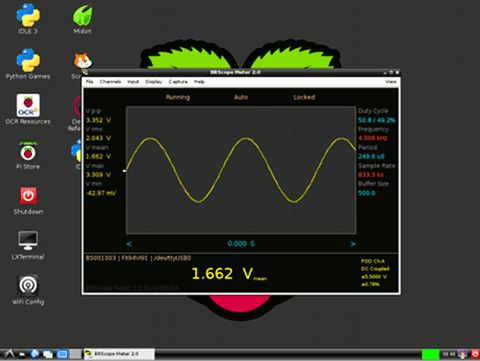
2013-11-09
Recently we ported BitScope DSO to prove it was possible to build a Raspberry Pi Oscilloscope based on BitScope.
We've now started porting all the other BitScope software applications including Logic, Chart, Meter and BitScope Library to Raspberry Pi.
The next application that we've ported is BitScope Meter shown here and works very well. It is an automatic oscilloscope that you simply turn on, connect your signal and observe the results.
It works like a waveform generator in reverse. It locks onto the fundamental frequency of the signal (if there is one) and adjusts its timebase and voltage scale to optimize the waveform display and minimize quantization noise.
It captures and updates the display and reports the waveform period, frequency, duty-cycle, minimum, maximum, peak, average and RMS voltages in real-time. It's an ideal tool to quickly view and measure AC/DC signals and voltages and its simplicitly lends itself to novice users, students and anyone who simply wants to make some quick measurements.
It works best with a locally connected BitScope but you can try Meter with the Sydney BitScope. Your mileage may vary if there are other people accessing it at the same time because unlike DSO, Meter uses successive capture frames to do what it does. If someone else changes a parameter using DSO mid-stream you may get unpredicable results.
We've added BitScope Meter to the download menu on the BitScope Pi Page. Follow the same instructions for installing BitScope DSO but choose the BitScope Meter package instead of DSO; it installs the same way.
In the meantime, we've been working on a range of optimizations designed to improve the performance of BitScope DSO when run on the relatively lower powered RPi with its (currently) non-accelerated graphics and we're making some good progress. We hope to have an update available for download sometime next week!